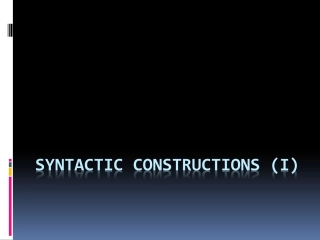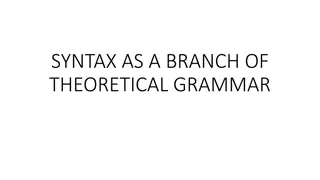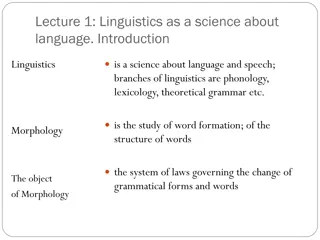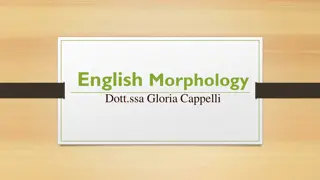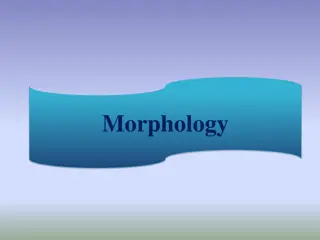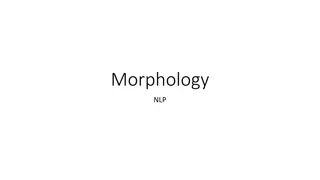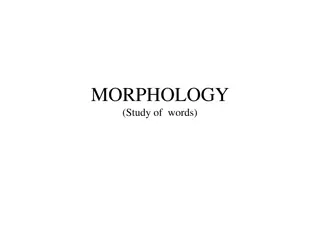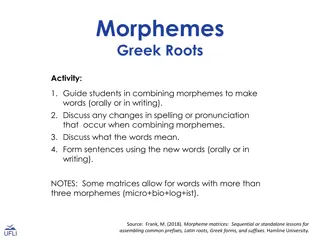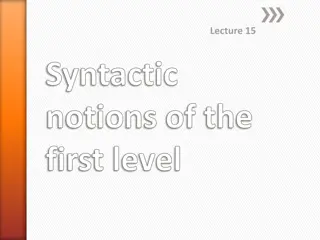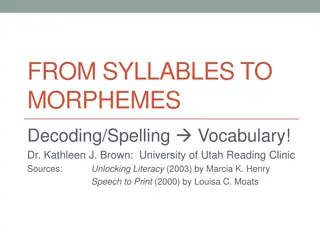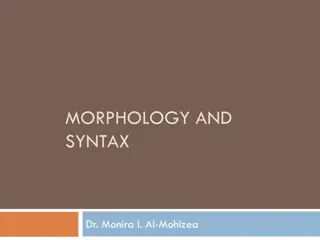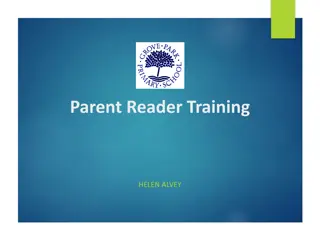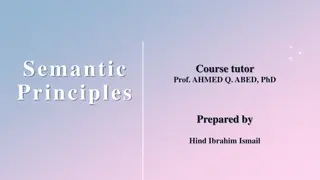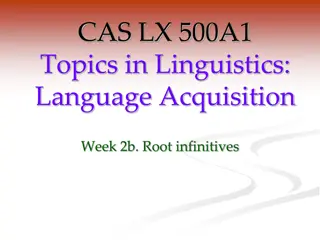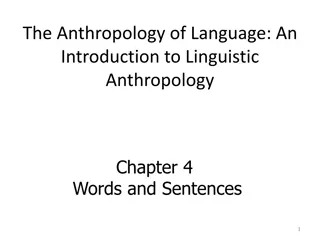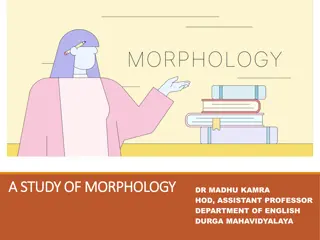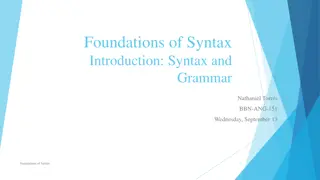Lexemes, Syntactic Words, and Morphemes
Lexemes, syntactic words, and morphemes are fundamental units of language with distinct characteristics and roles. Lexemes form the basis for inflected variants, while morphemes are the smallest meaningful units that create words. The intricate interplay between allomorphs, phonological conditioning, and morphological rules shapes the structure of language. Explore the intricacies of language construction through these essential elements.
Uploaded on Feb 27, 2025 | 1 Views
Download Presentation

Please find below an Image/Link to download the presentation.
The content on the website is provided AS IS for your information and personal use only. It may not be sold, licensed, or shared on other websites without obtaining consent from the author.If you encounter any issues during the download, it is possible that the publisher has removed the file from their server.
You are allowed to download the files provided on this website for personal or commercial use, subject to the condition that they are used lawfully. All files are the property of their respective owners.
The content on the website is provided AS IS for your information and personal use only. It may not be sold, licensed, or shared on other websites without obtaining consent from the author.
E N D
Presentation Transcript
Words The term word can be used in different senses. On the one hand, vocabulary items, i.e. entries in the dictionary (e.g. take), are called words, but on the other hand the different inflected forms of a word (e.g. take, takes, taking, took, taken) are also called words. Moreover, some words (e.g. life insurance), are said to be written in two words . To avoid confusion, we shall use the following terms: lexeme, syntactic word, and orthographic word. A lexeme is a unit of the lexicon (an entry in the dictionary, a vocabulary item), which is an uninflected abstract form that underlies all its inflected variants. A syntactic word is an inflected variant of a lexeme (including the zero-inflection), so take, takes, taking, took, taken are syntactic words. The whole set of inflected variants of a lexeme is called a paradigm. The forms take, takes, taking, took, taken constitute the paradigm of TAKE. The members of such a paradigm are syntactic words.
Words The third sense in which the word word is popularly used is a unit of writing: it is a stretch of graphic symbols with a space on either side and no space within. This will be called orthographic word. Lexemes can be likened to types, syntactic words to tokens, i.e. particular instances of the abstract types. Lexemes (and their inflected variants, the syntactic words) belong to different syntactic categories (= word classes, parts of speech). Nouns, verbs, adjectives, adverbs and prepositions are content words, others, e.g. conjunctions, pronouns, auxiliaries are function words.
Morphemes Morphemes are the smallest meaningful units of language, which cannot be subdivided without losing their meaning. They are abstract units, indicated between braces: { }. Lexemes and syntactic words are composed of one or more than one morpheme. For instance, the lexeme TEACHER consists of two morphemes: {teach}{-er}, the lexeme ALBATROSS consists of one: {albatross}. When we realise morphemes, we produce morphs. Morphs are the physical realisations of morphemes. The billions of actual morphs realising an abstract morpheme by actual speakers in actual situations can be grouped into a few phonologically different shapes, so called allomorphs. Allomorphs are the positional alternates of a morpheme: they have the same meaning and are in complementary distribution.
Morphemes The phonological differences between the allomorphs of a morpheme are often due to the phonological environment, i.e. the phonological differences are often phonologically conditioned. For instance, {-s}, the abstract plural morpheme in English has three regular allomorphs. When the last sound of the noun is a sibilant (i.e. /s, z/), the allomorph will be /iz/, as in e.g. boxes, bushes. In other cases the phonological differences of the allomorphs can be due to lexical conditioning. For instance, the plural morpheme is realised as / n/ when it is attached to the noun ox. The phonological difference of the allomorphs can also be caused by morphological conditioning. This happens e.g. in the plural noun houses, i.e.{house}{-s}.
Morphemes Morphemes can be grouped into two types on the basis of whether or not they can form mono-morphemic words. If they can occur by themselves as whole words, (i.e. if they can form mono- morphemic words), then we call them free morphemes. For instance, {house}, {albatross}, {kangaroo}, {lullaby}, {table} are free morphemes. But there are also morphemes which must be attached to other morphemes within words, these are called bound morphemes. For example, the plural morpheme {-s}, or the adverb-forming morpheme {-ly} are bound morphemes. Most bound morphemes are affixes. In English, these are either suffixes (following stems) or prefixes (preceding stems). Suffixes in English are either inflectional or derivational.
Morphemes A stem is that part of a word which remains if we remove the suffix or prefix that has entered the word last. The stem is not necessarily a single morpheme, e.g. the stem of unfriendliness is unfriendly, the stem of unfriendly is friendly. If we remove all affixes, we arrive at the absolute stem, called root (also known as base), which is always a single morpheme. Thus, the root of unfriendliness is {friend}. Conclusion: Morphemes are the smallest meaningful units of language or the units of allomorphic variation, which cannot be subdivided without losing their meaning or losing their allomorphic variability. To put it more informally, morphemes are recurring word-parts which have some constant variants, and which are typically but not necessarily meaningful.
Segmentability of words into morphemes There are words which are easy to segment into morphemes, e.g. {un-}{friend}{-li}{- ness}, {girl}{-s}, etc. Languages in which most words are of this kind (i.e. in which most words are sequences of separable morphemes) are called agglutinating languages. There are also many words which are mono-morphemic, i.e. which are composed of single morphemes. In these, morphemes coincide with words, e.g. go, coffee, elephant. Languages in which most words consist of single morphemes are called isolating languages. Finally, there are words in which the constituent abstract morphemes are fused together in an inseparable way, e.g. the English words took and mice consist of {take}{-ed} and {mouse}{-s}, respectively. Languages in which the fusion of morphemes is typical are called fusional (= inflecting) languages.
Word formation In addition to the borrowing of loanwords from other languages, e.g. ALCOHOL from Arabic) or the introduction of coinages (lexemes artificially invented, e.g. XEROX), there are also ways in which we can produce new lexemes, making use of old ones. These ways are called word formation processes. One of the major word-forming processes is derivation (= affixation), i.e. creating a new lexeme by means of adding a derivational prefix or suffix to an old lexeme. For instance, the lexeme KINGDOM is derived from the stem {king}, to which the derivational suffix {-dom} has been added. The lexemes produced by affixation can be called derivative words, or simply just derivatives.
Word formation It can happen that a lexeme is assigned to another word class (part of speech) without changing its form. This is called conversion (also known as zero affixation), which is extremely common in English, e.g. BOTTLE (noun) BOTTLE (verb), MILK (noun) MILK (verb). A special subtype of conversion is called approximate conversion, in which lexemes undergo a small but systematic change in pronunciation and are thereby assigned to a different word class. Sometimes this small change is a stress shift (with some changes in vowel quality), as in e.g. SUS PECT (verb) and SUSPECT (noun), PER MIT (verb) and PERMIT (noun). The next major word-forming process is compounding. This means bringing together two roots or two lexemes to produce a new lexeme, called a compound, e.g. BLACKMAIL, GOLDFISH, WHITE HOUSE (where the president of the US lives), HAY FEVER, CHRISTMAS-TREE, CHRISTMAS PUDDING, etc.
Word formation Other word-formation processes include clipping, blending, backformation and the formation of acronyms. Clipping means shortening a lexeme and thus producing a more informal variant, e.g. PHOTOGRAPH PHOTO, INFLUENZA FLU, EXAMINATION EXAM, etc. Blending is putting together lexemes but at least one of these lexemes is present only in a fragmentary form, as in e.g. FOG + SMOKE SMOG, BREAKFAST + LUNCH BRUNCH, etc. The lexemes so produced are blends. A kind of reverse affixation takes place in backformation. DONATE has been back- formed from DONATION (by analogy with pairs such as CREATION and CREATE). Finally, acronym formation means forming a lexeme from the initial letters or larger parts of words; the lexemes so created are acronyms. Many of these are pronounced as words, e.g. RADAR for radio detecting and ranging , NATO for North Atlantic Treaty Organization .


